


Project name: Ecological restoration landscape design of Xichuan, Zhengzhou
Company name: Horizon & Atmosphere Landscape Co.
Website:www.hsland.com.cn
Contact e-mail:tangqin@hsland.com.cn
Completion Year:2016 June ~ present
Design Team:Weihan Lu, Qingwen Zhang, Shuangyou Huang, Dan Lu, Jiaxiang Xu, Hao Yu, Hao Guo, Chaohua Tang, Wanjun Li, Wenhui Lin, Jun Wang, Xingyu Yu, Ziyu Hua
Project location:Dameng Town, Zhongmou County, Zhengzhou, Henan Province, China
Building area:139,000 sq. km
Copyright of photography:琢墨摄影
Client:普罗中国
01 Origin of design
Xichuan, an agricultural irrigation canal known as ‘Xigan Canal’ before, stretches for 31 kilometers from the south bank of the Yellow River to Moushan Wetland Park in Zhengzhou.
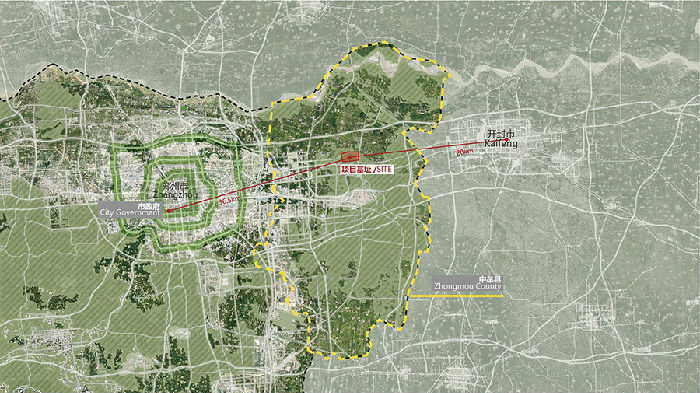
Project location map © 翰祥景观
In nearly a decade, the city water system planning is on the agenda with the construction of Zhengzhou industrial park. The role of Xigan Canal has changed to better combining with the on-going development planning of the Yanming Lake area, Zhongmou County, Zhengzhou. Therefore, Xigan Canal is asked to both meet the requirement of irrigation function and create a recreation space for public entertainment and leisure, which can ultimately promote the fusion of nature and humankind.Considering about the overall planning, Xichuan, restored and designed under our charge, is located between Xinwang check gate and Zhulu camp in Dameng Town, Zhongmou County, Zhengzhou. The reconstruction section with a total length of about 2.1 kilometers is defined as the demonstration section of water system reconstruction in Zhongmou County. Its completion will provide guidance for the improvement of regional water systems, especially irrigation channels.

Water system planning for Zhengzhou International Cultural and Creative Industry Park (2015-2030). Xigan Canal is defined as landscape water system which functioned both as urban landscape and waterfront leisure © 翰祥景观
02 Site description
Dameng Town belongs to the north temperate continental monsoon climate with mean annual temperature of 14.2 ℃ and mean annual precipitation of 616 mm. It has moderate temperature and distinct seasons with dry spring, hot rainy summer, sunny autumn and cold winter with little snow. There are total 124 rivers in this area which belong to Yellow River and Huai River. Xigan Canal belongs to Yellow River water system, which water source is the irrigation and diversion of the Yellow River with a small water yield. The canal is about 6 meters wide and 1.5 meters deep, and its base is made of all-hard concrete structure for the aim of improving irrigation efficiency. The farmland around the reconstruction area is flat and has been largely abandoned, resulted in a massive number of agricultural household garbage, weeds and twigs floating on the surface of water. Hence, due to its weak purification capacity and generally eutrophic water body, the canal basically cannot function as a water ecosystem.
03 Design strategy: from ‘Xigan Canal’ to ‘Xichuan’
With the acceleration of urban expansion and renewal, a lot of agricultural land has been abandoned in the process of development. A large number of artificial intervention and exploitation have affected the whole ecological environment system, with fewer and fewer native plants and animals left, and the environment of habitat becoming worse and worse. Xigan Canal is a typical case in this way.
The Xigan Canal reconstruction project aims to restore the blue belt ecosystem of the canal and its surrounding areas, and rebuild the continuity and integrity of the river water ecological system. More importantly, this project can help purify the water body and bring the construction of habitat environment into the essential process of city development, which would reconstruct the link between nature and humankind and create vitality and sense of belonging for the city. Last but not the least, transforming the ‘Xigan Canal’, a dirty and dilapidated irrigation canal, into a clean and indispensable ‘Xichuan’ would be an important, new bond to connect city, environment and residents.
At the beginning of the design, we sampled the water quality of the upstream, midstream and downstream of Xigan Canal. The water quality report shows that the water quality problem in the canal is mainly due to organic pollution and the high content of nutrients such as nitrogen and phosphorus, which will lead to the rapid propagation of algae and the continuous deterioration of the water, and importantly, the loss of self-purification function. Therefore, regulation of water pollution and reconstruction of ecosystem have become the biggest challenge of this project. Based on the design objectives and the existing situation, we formulated the following design strategies and try to solve the problems of Xigan Canal step by step:
1. Research on the pollution source of Xigan Canal, understand and solve the water pollution problem, rebuild the water ecosystem and make the water self-purifying.
2. Construct the ecological environment at the surrounding area of Xigan Canal and create the transition space of blue and green belt and wetland space synchronously. Enrich regional animal and plant species, make the whole ecological cycle system form a closed loop, and finally achieve the goal of sustainable development.
3. On this basis, we are trying to rebuild the spatial function of the river bank and guide the residents to enjoy and use it through the design, and make the living life and the river ecosystem co-exist harmoniously, and finally realize the design vision.
04 Research of pollution sources
After plenty of field investigations and discussions with relevant experts, we found that the two main causes of water pollution in the reconstruction area of Xigan Canal are as follows:
The internal pollution source of canal
1) Upstream water pollution
The upstream water of canal has brought plenty of garbage from agriculture, construction and household including dry branches and leaves, plastic things and wasted farming products, which combined the aquatic plants and algae along the way in the canal into flocculation and thus exacerbating the outbreak of water eutrophication and algal bloom.
2) Floatation pollution
Pollutants floating in the canal, including decaying aquatic plants and household garbage, interact with each other and gradually form into humus-like products. This would not only affect the water surface landscape of the canal, but also increase the organic matter content in the canal and aggravate water pollution, result in the continuous deterioration of water quality.
3) Sediment pollution
The continuous formation and deposition of anaerobic sludge and humus in the canal would increase the concentration of water pollutants. The microbial degradation of organic pollutants in the bottom sediments would consume the dissolved oxygen in the water. At the same time, the adsorbed pollutants in the suspension process of the bottom sediments would diffuse and release to the surrounding water, causing secondary pollution. These impacts would continuously reduce the dissolved oxygen in the water and form black and foul water, resulting in a vicious cycle of water eutrophication in the canal.

The situation of canal before reconstruction: upstream pollution, floating pollution and sediment pollution are the main cause of internal pollution. © 翰祥景观
The external pollution source of canal
1) Sanitary sewage
Sanitary sewage showed high concentration of nitrogen, phosphorus and organic matters, in which ‘black water’ (including fecal urine and toilet flushing water) and ‘grey water’ (e.g. bath, laundry and kitchen wasted water) are largely different from each other in water quality and quantity. Some sanitary sewage also contains heavy metals and toxic, harmful substances which leads to great fluctuation in water quality. The self-purification function would be overloaded when sanitary sewage entering into the canal. Sanitary sewage is an important external pollution source of canal which can easily cause water eutrophication.
2) Household waste
The household garbage of the villagers around the canal, solid food garbage and the waste in the construction process would be discharged into the canal and pollute the water body to different degrees. Meanwhile, during the garbage stacking process, a large number of acidic and alkaline organic pollutants including dissolution of some heavy metals, could be washed into the canal by raindrops and thus polluting the water.
3) Non-point pollution
Non-point pollution includes plant-unutilized fertilizers, pesticides and nutrients applied in agricultural production process, and surface runoff of sewage generated by road greening etc. These pollutants would enter the water through surface runoff, drainage and underground leaching in the process of precipitation, irrigation and discharging, thus forming into non-point pollution. They would harm the natural ecological function of the water body, make surface water eutrophication and nitrate content of groundwater exceeding the standard, and finally affect the sustainable use of water resources.

The situation of canal before reconstruction: Sanitary sewage, household waste and non-point pollution are the main cause of external pollution. © 翰祥景观
05 Ecological water purify system
Based on the results of our pollution sources research, we found that the problem of sanitary sewage and non-point pollution of upstream could not be solved in the reconstruction process of Xigan Canal. It is particularly important to purify the water ecologically in the reconstruction area. Therefore, the first key emphasis in our reconstruction work is to design a water purification system. We hope to establish an adequate ecological purification system and help the canal develop and gradually improve its own purification capacity, furthermore building a healthy self-purification cycle and minimizing artificial intervention, and finally achieving sustainable goals.
Step 1: Purify the upstream water by ecological means, such as sedimentation, filtration etc.
We choose to purify the upstream water before it comes into the canal. The upstream inlet adopts biological interception to isolate large suspended solids such as domestic garbage, and sets sand sink to remove suspended particles. Only after the water quality is optimized by the combined purification method of ‘microbial purification(微生物净化)’, ‘surface runoff wetland purification(表流湿地)’ and ‘underwater forest purification(水下森林)’ can it flow into the reconstruction section of Xigan Canal.
Step 2: Build ‘underwater forest purification’ and ‘surface runoff wetland purification’ through the whole basin and develop self-purify capacity of the canal.
In order to provide the attachment space for microbial growth, we are trying to plant a large area of Vallisneria spiralis underwater, which is the main vegetation and can endure cold and survive through winter. Together with the planting of emergent aquatic plant such as Nymphaea alba, Acorus calamus, Iris tectorum etc., ‘ underwater forest perification’ would be built and help increase the content of oxygen in water. We have created nearly 20 wetlands with different sizes within the 1.5 km canal that reconstruction completed, which would provide habitats for living creatures and create a harmonious environment between nature and human.

The ecological water purify system of ‘Xichuan’ © 翰祥景观
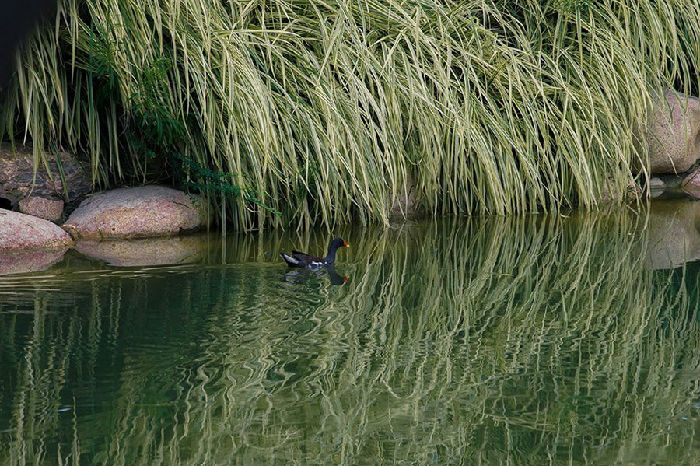

The Xichuan water becomes clear and clean which meets the national three-class water standard after ecological purification © 琢墨摄影
Step 3: Restore the natural shape of river band by removing the artificial, hard riverbed.
On the other hand, in order to solve sediment pollution and floatation pollution and improve the self-purify capacity of the canal through ecological methods, we broke the original structure of the canal and restored the canal morphology of natural meandering river form. We removed the artificial, hard riverbed and expanded the cross-section of the riverbed (from 6 meters to 10-15 meters), in order to slow the flow rate and allow aquatic animals and microbes to make home there. Moreover, we created porous structure using ecological methods such as stone cage石笼, piled stone垒石 and cedar piles杉木桩 to reform the concrete revetment, which would provide a smoother water and habitat for amphibians and spawning fish. So far, the reconstruction section of the ‘Xigan Canal’ has been reborn into ‘Xichuan’.

reconstruction diagram © 翰祥景观
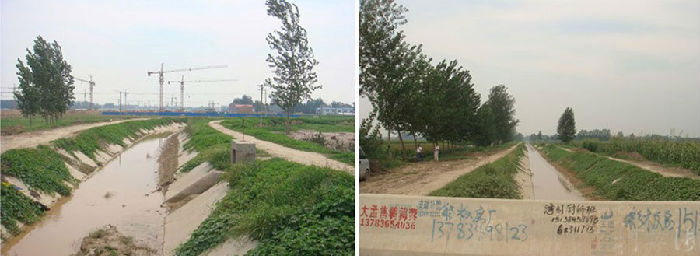
Before reconstruction – ‘Xigan Canal’ © 翰祥景观
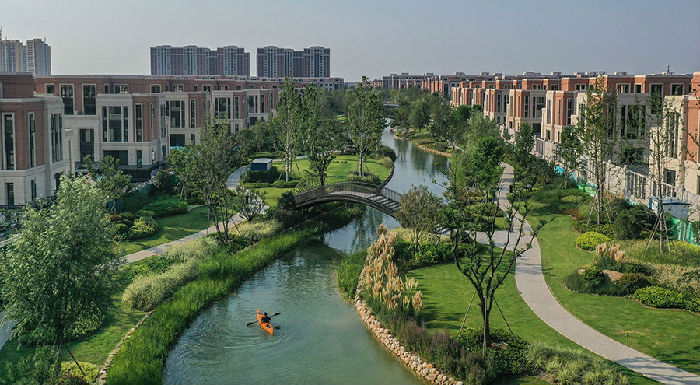
After reconstruction – reborn into ‘Xichuan’


Ecological revetment method © 翰祥景观

Scene of ecological revetment completed
06 Build a river ecosystem
The key factor in enhancing ecosystem stability is to increase plant species diversity. Therefore, we are trying to facilitate ecological restoration through multi-dimensional design of different kinds of plants. Through field survey and research on the local species of food source plants to provide possibility for biological feeding, we listed the plant species as follows: main tree species as Salix babylonica, Pterocarya stenoptera, Metasequoia glyptostroboides, Sapium sebiferum, Sophora japonica, Broussonetia papyifera, Cedrus deodara; shrubs using water-resistant perennial as Miscanthus sinensis cv., Pennisetum alopecuroides, Iris tectorum, Lythrum salicaria, Cortaderia ‘Pumila’. At the same time, we also chose emergent aquatic plant and floating plant to match them to create a diverse vegetative environment.
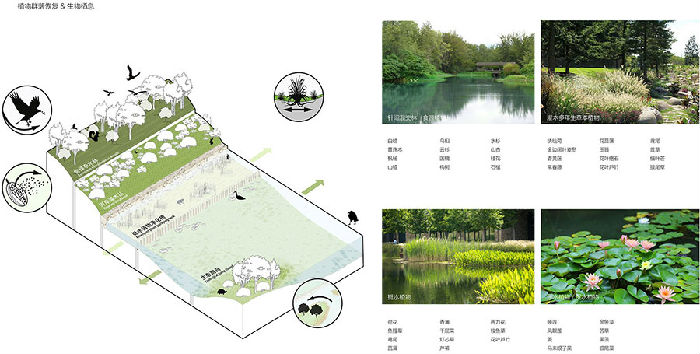
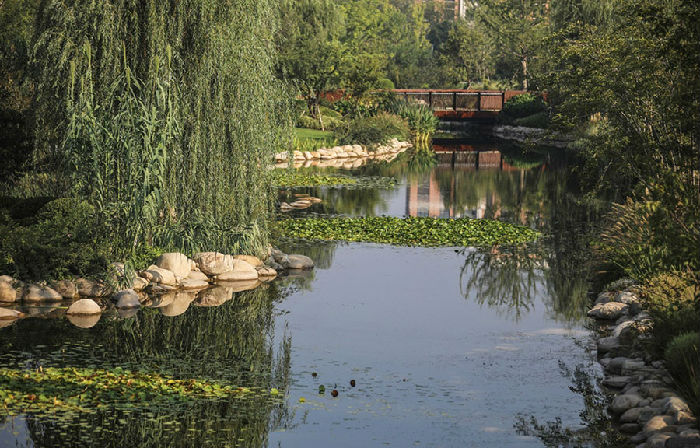


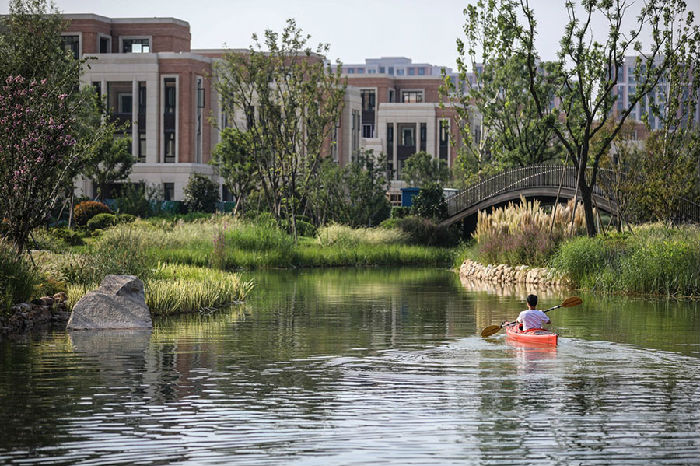
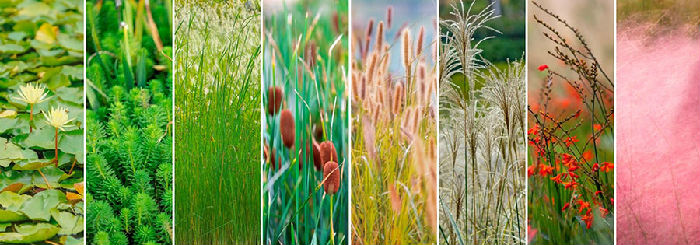
The finished ‘Xichuan’ owned 165 species of trees, 102 species of shrubs and 20 species of aquatic plants © 琢墨摄影
According to the habitat preferences of animals with different feeding and activity characteristics, we have made great efforts on enriching the structure of the habitat food chain and providing a safe, avoidable and interference-free environment for the aim of ensuring habitat reproduction and migration.
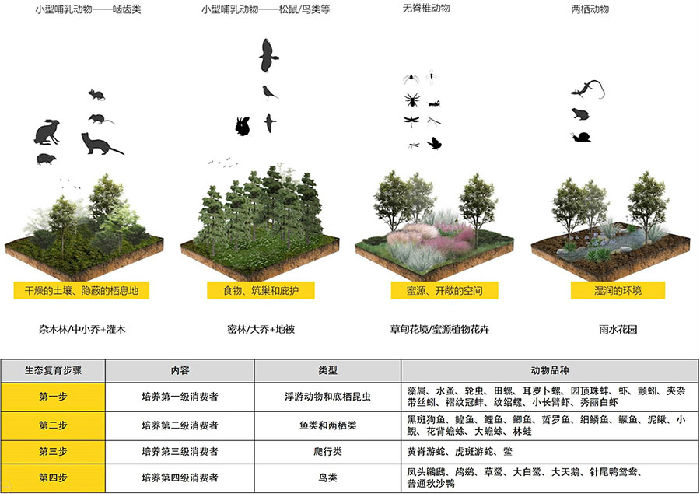
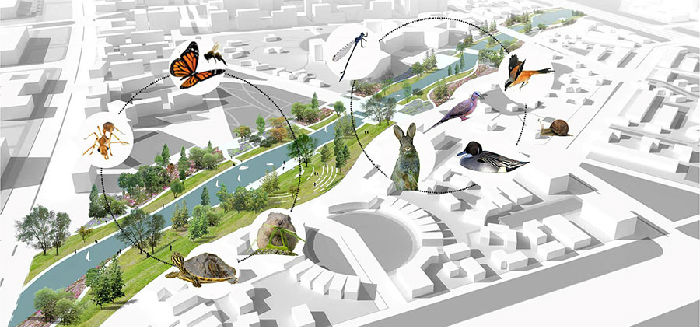
Design a variety of habitats based on animal feeding preferences © 翰祥景观
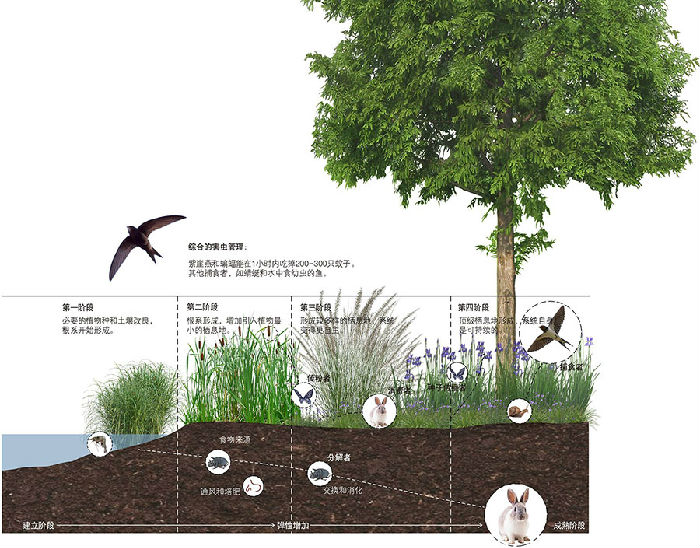
Cultivate different animals as consumers step by step, ultimately creating a healthy and sustainable ecosystem. © 翰祥景观

One year after the completion of the first part of ‘Xichuan’ and the fourth-level consumers have appeared here. © 琢墨摄影
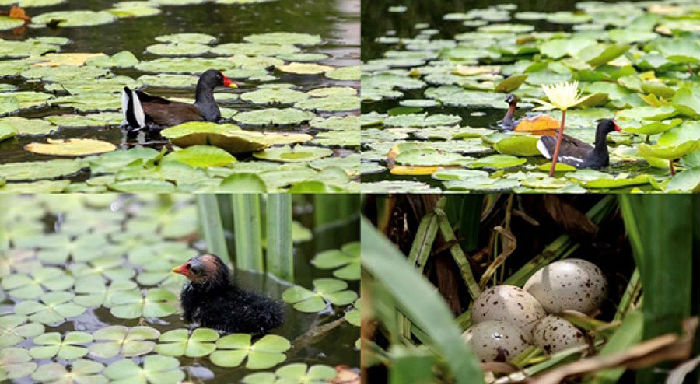
This summer we found Gallinula chloropus, one of the national protective wildlife, settled down in ‘Xichuan’. © 琢墨摄影
07 Define the riverbank functional space
We regarded the riverside promenade as a relatively independent system, which would enhance the connection and contact between water and people through the change of its own form. A safe waterfront space was created by widening the canal surface (from 6 m to 10-15 m) and reducing the bottom depth (from 2 m to 0.8 m). Various kinds of hydrological geomorphology would bring us different scale experiences of the canal, which would add fun to the journey. The construction of residents’ life rest and social arena would create life memory points, thereby improving the residents’ sense of responsibility for environmental protection.

Hydrological and geomorphological distribution of ‘Xichuan’ © 翰祥景观

Profile figure 1-1. Tree-lined walkway aside the canal © 翰祥景观
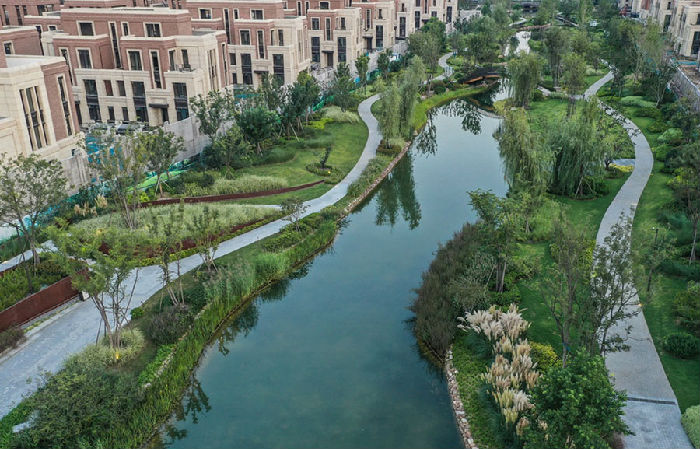
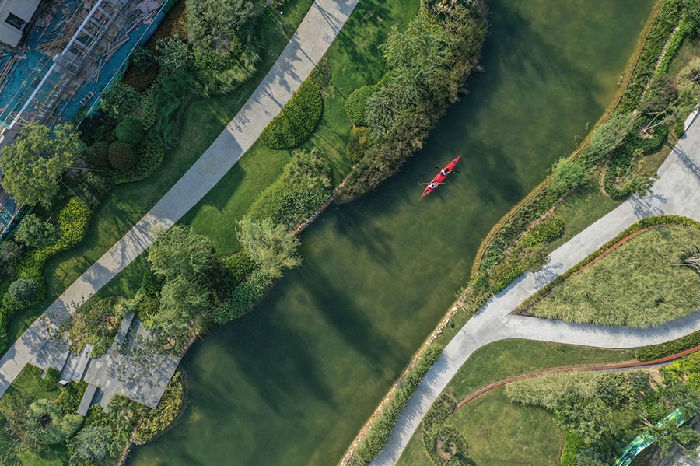
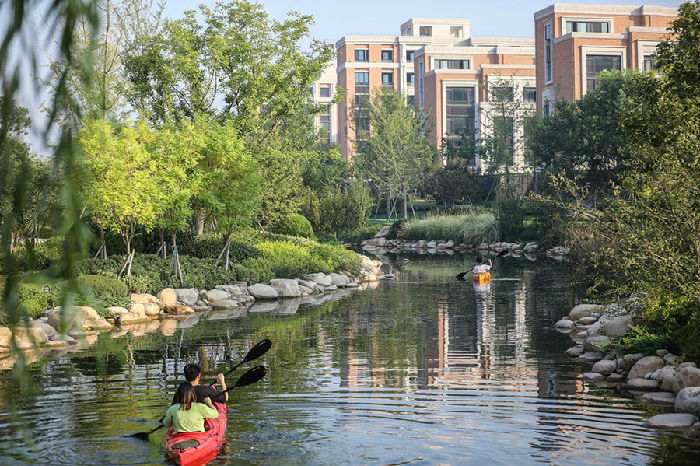
Tree-lined walkway with space of canal bank © 翰祥景观

Profile figure 2-2. Canal space connecting the living area © 翰祥景观

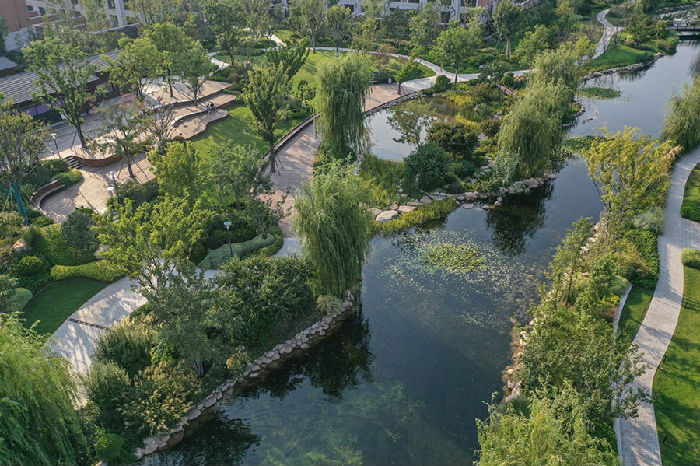
Canal space connecting the living area © 琢墨摄影

Dynamic analysis of human activities in ‘Xichuan’ © 翰祥景观
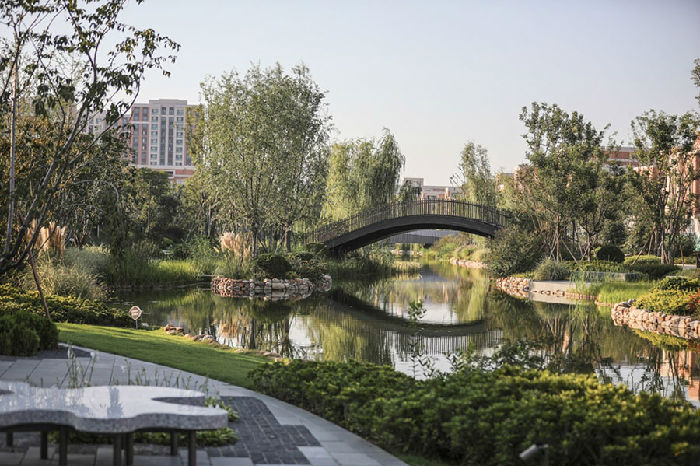
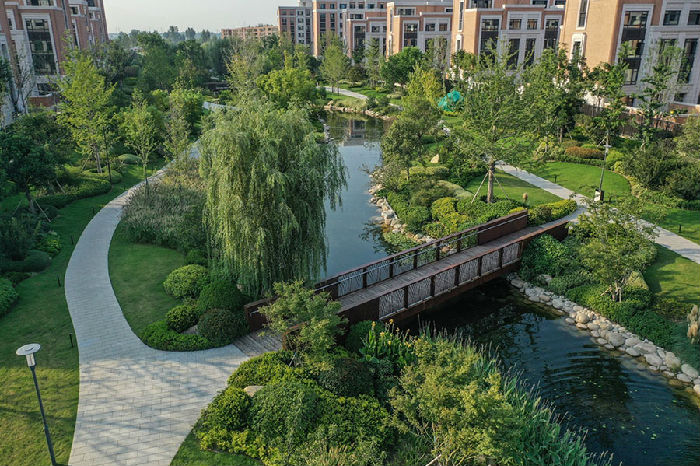
Make comprehensive consideration of the footpath, bridge and cruise ship moving line, for the aim of building a rich wandering experience© 琢墨摄影

Analysis of human activity space in ‘Xichuan’ © 翰祥景观

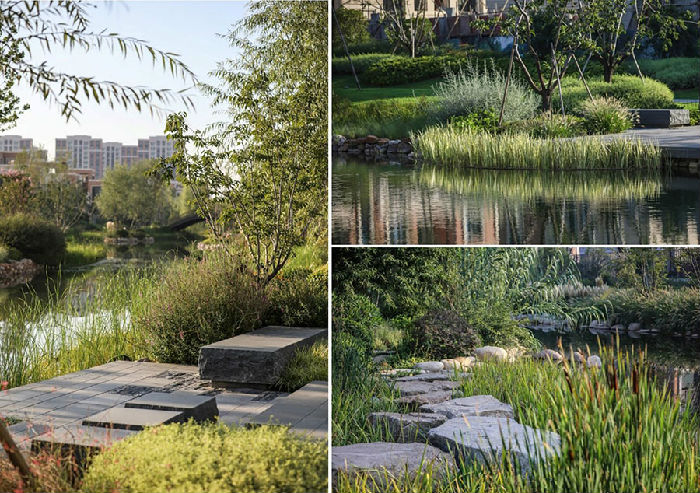
The riverside promenade, as an independent system, is connected with ‘Xichuan’ in various ways © 琢墨摄影
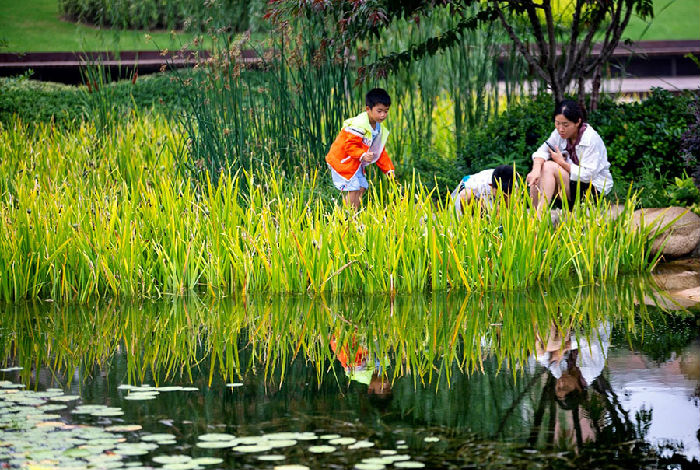
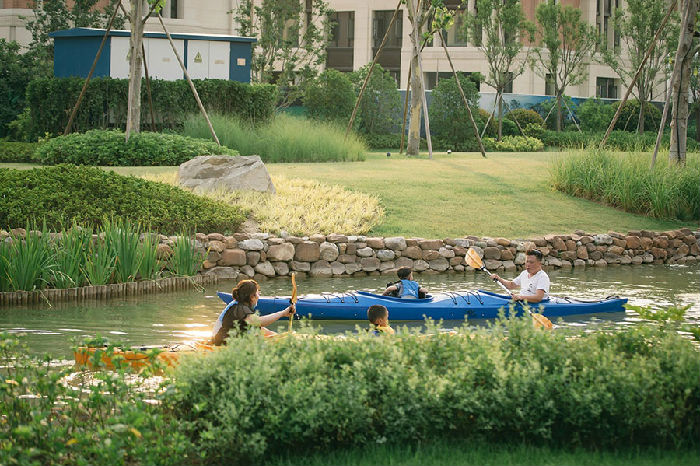
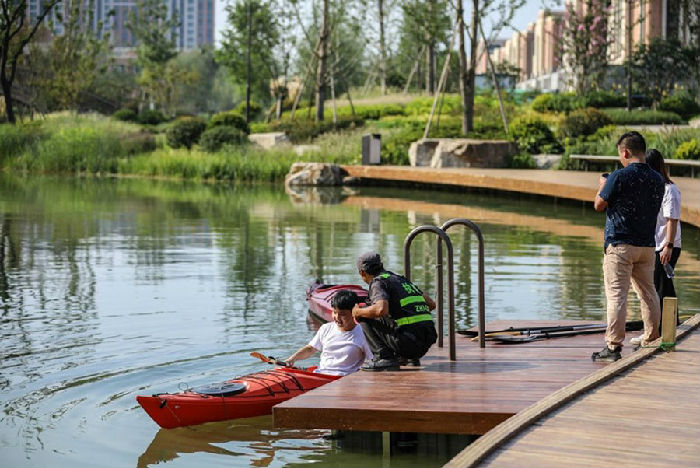
The rich activity space of ‘Xichuan’ enables urban residents to experience diverse interests © 琢墨摄影
08 Summary
Urban development and natural environment have always been separated from ancient times, while they should be integrated now. The aim of increasing the resilience and capacity of the city is vital on the face of extreme climate change in the future. The success in ‘Xichuan’ can help our city to better facing the future challenges.
After ecological reconstruction, ‘Xichuan’ is capable of self-purifying and alleviating the problem of rain and flood. It is able to provide habitats for wildlife and create more entertainment space for citizens, which would provide more opportunities for residents to get close to nature.
So far, 1.5 km of ‘Xichuan’ has been successively renovated, and its water quality has reached the third-class water standard. Aside from the native species, we have found 20 species of wild plants, 12 species of birds, more than 60 species of insects and some amphibians have settled down here. The species diversity of the canal has increased by 30 %, and even Gallinula chloropus, a national protective wildlife, have been found nesting and breeding here. We have achieved the initial success of the construction of aquatic ecosystem, and expect the continuous construction of ‘Xichuan’ would take on a more natural and complete appearance over time.

Aerial view © 琢墨摄影
Source: <http://www.landscape.cn/landscape/11368.html>